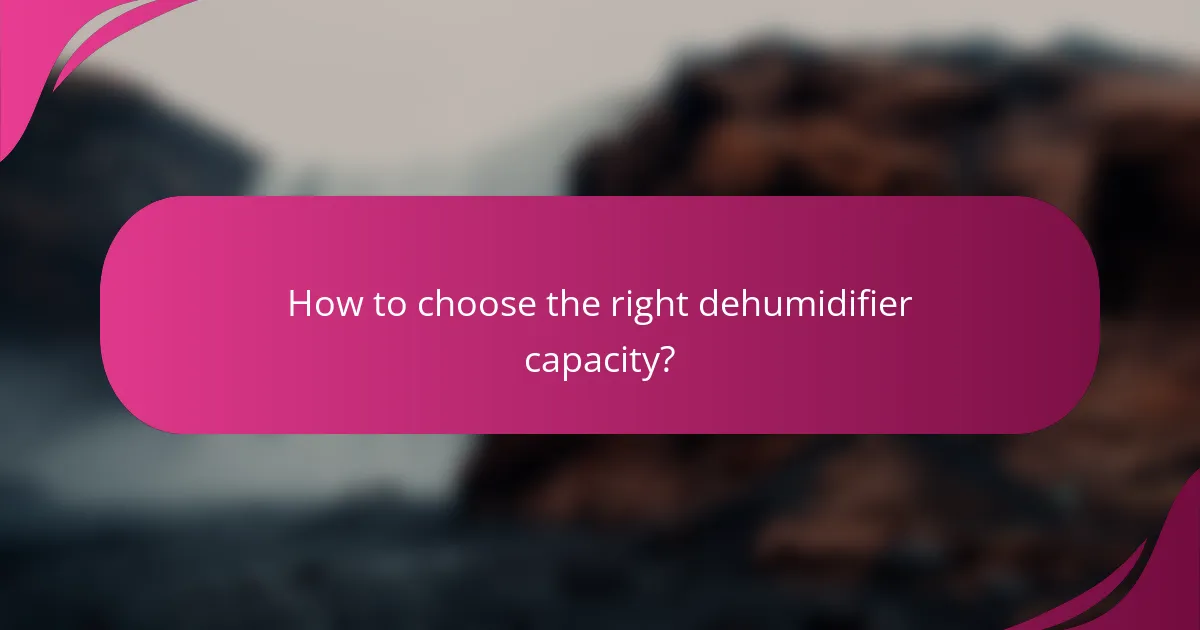Choosing the right dehumidifier is essential for effectively managing humidity levels in your home, especially in damp areas like basements. It’s important to select a model with the appropriate capacity, typically ranging from 30 to 70 pints per day, based on the size of your space and existing humidity levels. This ensures optimal performance and a comfortable living environment during the humid months.

What are the best dehumidifiers for Canadian homes?
The best dehumidifiers for Canadian homes effectively manage humidity levels, particularly in damp areas like basements. Look for models with a capacity suitable for your space, typically ranging from 30 to 70 pints, to ensure optimal performance during the humid months.
Frigidaire FFAD5033W1
The Frigidaire FFAD5033W1 is a popular choice for Canadian households, known for its efficient moisture removal of up to 50 pints per day. It features a continuous drain option, making it convenient for long-term use without frequent emptying.
This model operates quietly and includes a built-in humidistat, allowing users to set their desired humidity levels. Its portability is enhanced by the inclusion of caster wheels, making it easy to move between rooms as needed.
hOmeLabs 70 Pint Dehumidifier
The hOmeLabs 70 Pint Dehumidifier is designed for larger spaces, effectively removing moisture from areas up to 4,500 square feet. It is particularly suitable for basements and other high-humidity environments, making it ideal for many Canadian homes.
This unit features a user-friendly control panel and an auto-restart function, which is beneficial during power outages. Additionally, it has a washable filter that helps maintain air quality while reducing allergens.
Vremi 70 Pint Dehumidifier
The Vremi 70 Pint Dehumidifier is another excellent option for Canadian homes, capable of handling spaces up to 4,500 square feet. It is effective in reducing humidity levels and preventing mold growth, which is crucial in damp climates.
This model includes a built-in pump that allows for continuous drainage, making it easy to maintain without frequent emptying. Its sleek design and quiet operation make it a practical choice for living areas as well.

How to choose the right dehumidifier capacity?
Selecting the right dehumidifier capacity involves understanding the size of your space and the humidity levels present. A dehumidifier’s capacity is typically measured in pints per day, indicating how much moisture it can remove from the air.
Capacity based on room size
The capacity of a dehumidifier should align with the size of the room it will be used in. For small rooms up to 500 square feet, a unit with a capacity of 30 to 50 pints is often sufficient. Larger spaces, such as basements or open areas exceeding 1,000 square feet, may require units with capacities ranging from 50 to 70 pints.
To determine the right capacity, consider the room’s square footage and the moisture level. For example, a damp basement may need a higher capacity unit compared to a moderately humid laundry room of the same size.
Recommended pint capacity for humidity levels
The recommended pint capacity also varies based on the humidity levels in your area. In regions with high humidity, a dehumidifier with a capacity of 50 to 70 pints is advisable for spaces around 1,000 square feet. Conversely, in drier climates, a smaller unit of 30 to 50 pints may suffice.
As a general guideline, if the humidity level exceeds 60%, opt for a higher capacity model. Regularly monitor humidity levels with a hygrometer to ensure your dehumidifier meets your needs effectively.

What size dehumidifier do I need for my basement?
The size of the dehumidifier you need for your basement depends on the square footage and humidity levels. Generally, a unit’s capacity is measured in pints per day, which indicates how much moisture it can remove from the air.
Small basements (up to 500 sq ft)
For small basements, a dehumidifier with a capacity of around 30 to 50 pints per day is typically sufficient. These units can effectively manage humidity levels in spaces that are prone to dampness without being overly powerful.
When selecting a dehumidifier for a small basement, consider models that are compact and energy-efficient. Look for features like automatic shut-off and continuous drainage options to simplify maintenance.
Medium basements (500-1000 sq ft)
Medium basements require dehumidifiers with a capacity of 50 to 70 pints per day. This range is ideal for handling moderate humidity levels and ensuring a comfortable environment.
Choose a unit that offers adjustable humidity settings and a built-in humidistat. These features allow for better control of moisture levels, helping to prevent mold growth and protect stored items.
Large basements (over 1000 sq ft)
For large basements, consider dehumidifiers with a capacity of 70 to 90 pints per day or more. These units are designed to handle significant moisture removal and are essential for maintaining air quality in expansive spaces.
When selecting a dehumidifier for a large basement, look for models with high airflow rates and multiple fan speeds. Additionally, consider units that can be connected to a drainage system to minimize manual emptying of the water reservoir.

What are the signs of high humidity in homes?
High humidity in homes can be identified through various signs that indicate excess moisture in the air. Recognizing these signs early can help prevent damage and health issues associated with prolonged exposure to humidity.
Visible mold growth
Visible mold growth is one of the most obvious indicators of high humidity. Mold thrives in damp environments, often appearing in areas with poor ventilation such as bathrooms, basements, and behind furniture. If you notice patches of mold, it’s essential to address the humidity issue promptly to prevent further spread.
To combat mold, consider using a dehumidifier to maintain indoor humidity levels between 30% and 50%. Regular cleaning and ensuring proper airflow can also help mitigate mold growth.
Musty odors
Musty odors often accompany high humidity and can signal the presence of mold or mildew. These unpleasant smells typically arise in areas with stagnant air and moisture accumulation. If you detect a musty scent, it’s a strong indication that humidity levels are too high.
To eliminate musty odors, first identify and address the source of moisture. Using air purifiers alongside dehumidifiers can help improve air quality and reduce odors effectively.
Condensation on windows
Condensation on windows is a common sign of high humidity, especially during colder months. When warm, moist air comes into contact with cool glass surfaces, it can lead to water droplets forming. This not only indicates excess humidity but can also contribute to mold growth and window damage if left unchecked.
To reduce condensation, consider using insulated windows or window treatments that minimize temperature differences. Additionally, maintaining indoor humidity levels within the recommended range can help prevent this issue.

What features should I consider in a dehumidifier?
When selecting a dehumidifier, consider features like energy efficiency, built-in humidistats, portability, and noise levels. These factors will significantly impact the unit’s performance, operational costs, and suitability for your space.
Energy efficiency ratings
Energy efficiency ratings indicate how much electricity a dehumidifier consumes relative to its moisture removal capacity. Look for units with an Energy Star certification, which signifies that they meet strict energy efficiency guidelines set by the U.S. Environmental Protection Agency.
Higher efficiency models can save you money on electricity bills, especially if you plan to run the dehumidifier frequently. Generally, aim for a unit that removes around 30 pints of moisture per day for small spaces and 50 pints for larger areas, while maintaining good energy efficiency.
Built-in humidistats
A built-in humidistat measures the humidity level in the room and automatically adjusts the dehumidifier’s operation to maintain your desired humidity. This feature helps prevent over-drying and optimizes energy use.
When choosing a dehumidifier, consider models with adjustable settings that allow you to set specific humidity levels. This way, you can customize the environment according to your comfort and health needs, which is especially important in humid climates.
Portability and noise levels
Portability is crucial if you plan to move the dehumidifier between rooms. Look for lightweight models with built-in handles and wheels for easy transport. Some units are designed for specific areas, such as basements or laundry rooms, which may affect their portability.
Noise levels can vary significantly between models. Check the decibel rating; quieter units typically operate around 40-50 dB, making them suitable for bedrooms or living areas. If noise is a concern, consider running the dehumidifier during the day when you’re less likely to be disturbed.

How do I maintain my dehumidifier?
Maintaining your dehumidifier involves regular cleaning and upkeep to ensure optimal performance. Key tasks include cleaning the water reservoir and checking the air filter, which can help extend the unit’s lifespan and efficiency.
Cleaning the water reservoir
To maintain your dehumidifier, regularly clean the water reservoir to prevent mold and bacteria growth. Empty the reservoir and wash it with warm, soapy water at least once a month, or more frequently if you notice any buildup.
After washing, rinse thoroughly and allow it to dry completely before reinserting it into the unit. This simple step helps maintain air quality and ensures the dehumidifier operates efficiently.
Additionally, check for any cracks or damage in the reservoir that could lead to leaks. If you find any issues, consider replacing the reservoir to avoid water damage and maintain optimal performance.
